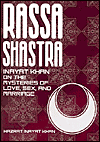
Khan’s treatise on sexuality stems from mystical perceptions of sex: “Sex is a direction. Two is a part of one, growing out of one…A single motion is not possible, a single stroke has no meaning…every single expression of activity reveals two aspects of directions of the same actions; and these may be distinguished from each other as its positive and negative aspects.” His philosophy anchors on the spiritual value of the male/female sexual relationship. Khan demonstrates a value and understanding of all heterosexual choices, including celibacy, polygamy, monogamy and prostitution. He does not extend this generosity to homosexuality, however, and under a chapter titled “Perversion” he clearly indicates his view of this as an illness without actually mentioning “homosexual” but still somehow hinting that women are more inclined towards such “perversion” than men. This one chapter falls out of step with the rest of the work: he otherwise demonstrates a near total acceptance of who people are, the choices they make, and he frequently cites anecdotes of both Muslim and Hindu piety. Like all works by Inayat Khan, this work reads as a twentieth century spiritual classic and the attitude of the times must be taken into account by the reader.
A practicing Sufi has much better qualifications to analyze and criticize the works of Khan; unfortunately, the Sufi tradition bars its adherents from questioning its elders. As a Westerner, this reader can say that Khan brought Sufism to the West but has yet to make Sufism fully accessible to western custom. Despite Khan’s failure to adapt the lessons to the culture, (at least with this Westerner) he left enough evidence of his thought process that perhaps a more globally integrated generation can set aside their biases and his to absorb the wisdom laced into his writing.
~review by Diana Rajchel
by Inayat KhanIbis Press, 2003
pp. 94, $12.95
